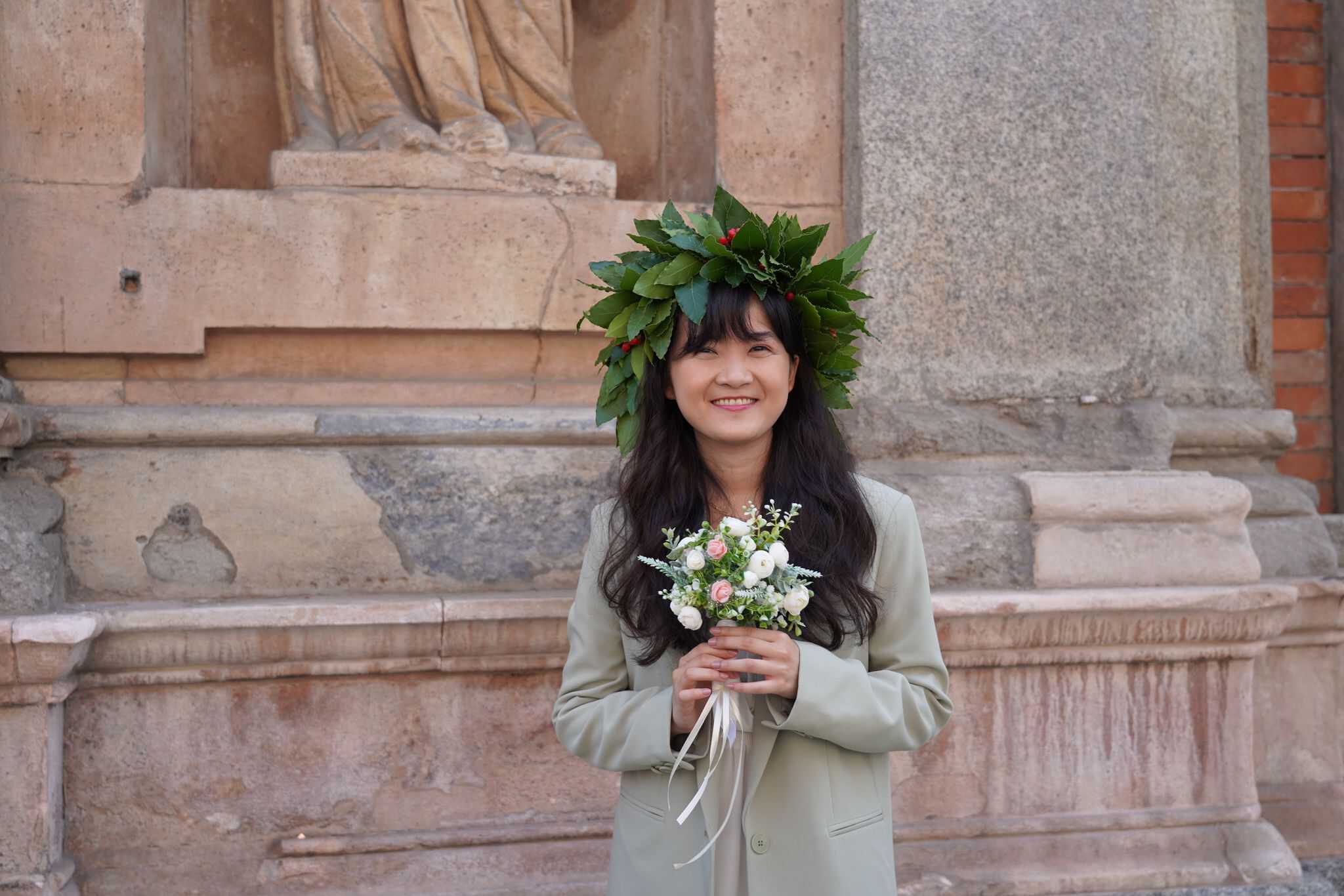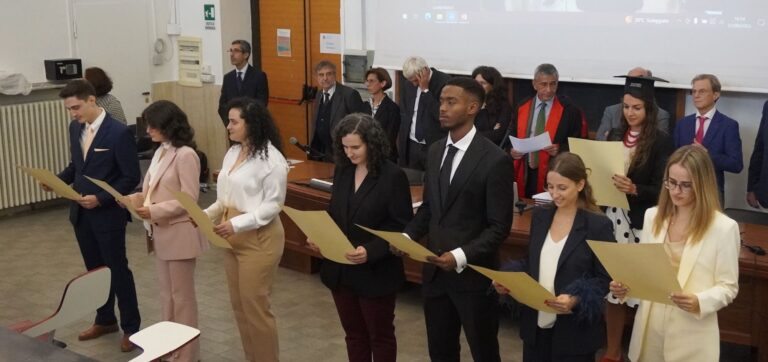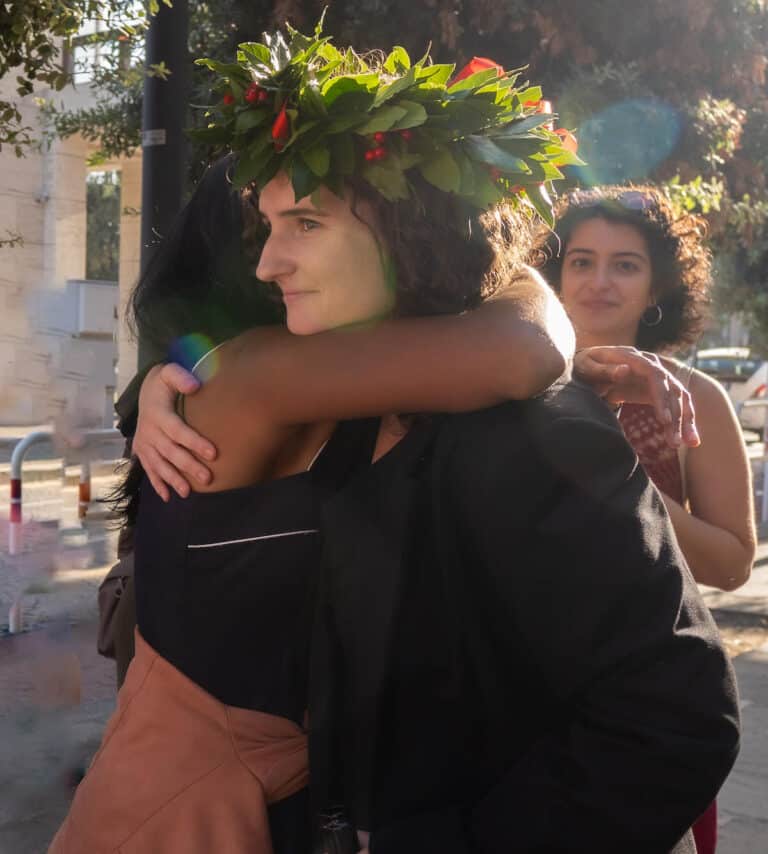Studying medicine in Italy requires a minimum of 6 years from the day of enrollment until you hold your diploma. Becoming a doctor begins with a dream and ends with a title, but the process is not as straightforward as you might think. It involves writing a thesis, defending it, completing mandatory internship hours, and registering for a license. There’s a lot that goes into it. In this article, we will provide a complete timeline of studying medicine in English in Italy, and discuss some of the more interesting traditions involved. A video summary of this article can be found here if you prefer to listen instead of read!

Timeline Overview: 6 Years of Studying Medicine
As mentioned in our article “how long is medical school in Italy?“, studying medicine in Italy typically takes six years, provided you stay on schedule with your exams. Many Italian universities offer a unique system that allows you to progress to the next academic year without completing all exams from the previous year.
The initial 2-3 years of medical school, often referred to as “pre-clinical years,” focus on foundational sciences. These provide the necessary background for understanding more complex, clinically oriented topics in subsequent years. For instance, a foundational knowledge of chemistry aids in understanding biochemistry, which in turn helps in understanding metabolic diseases and pharmacology.
The 4th year is when you start studying clinical subjects and can apply the knowledge you’ve been learning over the last few years. For example, in the 2nd year, you study physiology, which helps you understand HOW things in the body work. In 3rd year, you study pathology, which essentially helps you understand what can go wrong in the body. In 4th year, when you start applied pathology, you begin to learn how these things that go wrong in the body can manifest clinically, whether it’s signs or symptoms, or how you can reach a diagnosis by understanding the underlying pathological mechanisms. As you advance through your clinical years, the whole picture comes together to understand how to recognise, diagnose, and treat different conditions across various specialties.
Once you’ve completed all exams from the first four years of your medical school, you can start what is called the Tirocinio Pratico Valutativo per Esame di Stato (TPVES) internship. The TPVES is a total of 300 hours that takes place in the three fundamental fields of medicine: Surgery for 100 hours, Internal Medicine for 100 hours, and Family Medicine for 100 hours.
The 5th and 6th years are also when you should start considering writing your thesis, which is an original piece of work that you need to complete and defend in order to graduate. There are different types of theses, and the requirements to write one will greatly depend on the department you want to complete it in. In a more competitive department, a professor might require you to have above a certain average, or require you to come in for a year before you’re given a title to start writing. Regardless, this is a process that can take up to a year, so it’s good to start thinking about it once you get to 5th year.
If you complete all your exams and finish your thesis, you then file for graduation. It’s surprising to many people, but you are actually graded for your graduation as it’s the day you need to defend your thesis! If you are able to answer all of the questions the committee asks you based on the presentation of your thesis, you are now ready to graduate.
The committee decides on the final grades, they shake your hand and officially ‘proclaim’ you a doctor. You get to wear your custom-made corona d’alloro on your head, and celebrate with all of your friends and family.

How Long is the Medical Internship in Italy?
The official practical training in Italian medical schools known as the Tirocinio Pratico Valutativo per Esame di Stato (TPVES), is 300 hours of hands-on experience spread over a period of three months. This is broken down into three distinct areas of focus: 100 hours in internal medicine, 100 hours in surgical specialties, and 100 hours working with a general practitioner (also known as a family medicine doctor).
The requirement to start TPVES is the successful completion of all exams of the first four years of medical school. This ensures that students have the necessary theoretical knowledge to embark on their practical training journey. As part of the process, students are required to maintain a record of their training in a booklet. This booklet must be regularly updated and signed by the supervising medical tutor, usually a professor of that specialty. It serves as a record of the student’s progress and is a tangible document of their practical experience in order to file for graduation.
It’s important to note that if you enrolled in an international medical course before 2014, this practical training would have been completed after graduation. However, the curriculum has since been revised and the practical training is now integrated into the six-year course. It’s no longer possible to complete this component after graduation, and the allocated time for this training is “officially” the amount stated, so cannot be extended to cover 1 year as many students ask about.
While many students may be disappointed by what seems like the small number of practical experience hours, these are just the official requirements for licensure post-graduation. Numerous other opportunities exist for students to gain additional skills and experience in their own time, through their own organisation, or by participating in programs like Erasmus. These opportunities mean that no student needs to worry that their clinical skills will suffer, as long as they’re willing to be proactive about seeking opportunities. We have a video about maximising practical experience in an Italian medical school discussing this topic if you would like to learn more.
Writing a Medical Thesis in Italy
The process of writing a medical thesis in Italy typically starts in the 5th year of medical school. It is an original piece of work that can take up to a year to complete, requiring a significant amount of time, dedication, and research. It’s important to start thinking about the thesis topic early, considering the department you want to complete it in and the professor who might guide you. Some departments might require you to have above a certain average or require you to come in for a year before giving you a title to start writing.
Medical theses in Italy can fall into two broad categories: experimental and observational. Experimental projects involve formulating a hypothesis, conducting an experiment, and performing statistical analysis to either accept or reject the hypothesis. On the other hand, observational projects draw on existing research to draw conclusions, such as conducting a meta-analysis on a specific topic. It’s also worth noting that it’s possible to carry out a thesis outside your university, even abroad, with full funding, although opportunities for this vary greatly from one university to another.
Theses are carefully graded. The exact grading criteria can vary, but common factors include writing quality, type of thesis, subject mastery, and responses to questions that will be asked by the committee while defending it.
The length of the thesis, font size and type for the text, titles, spacing, logo placement, and bibliography style, etc., are all dictated by a university’s style guide, including the colours of the slideshow to present the thesis. While there are strict rules to adhere to regarding the content and printing of the thesis, the outside cover is generally up to the student’s preferences. You can select the outside binding, the colour and the texture of the covers, whether it will be printed in colour or black and white, and a few other options that not only determine how it will look but also the cost of printing it.
Defending Your Thesis and Graduation Day

Once your thesis is completed, the next step is to defend it on your graduation day. This process involves presenting your thesis to an audience, which can be made up of only a committee of professors or everyone attending that day, including all the graduates and their friends and family as well as the official thesis committee. You use a slideshow to introduce the underlying theory of your experiment, the methods and materials, the statistical analysis, and finally, an interpretation of your findings. Following the presentation, the committee will ask you questions, which you need to answer in order to graduate. The quality of your presentation, as well as your answers to the committee, will determine your final grade for the thesis, and your final graduation score out of 110. If you successfully answer all of the committee’s questions, you are ready to graduate and officially be proclaimed a doctor.
After you are declared a doctor, you and your graduating cohort read (or don’t read, considering some of the controversial takes) the Hippocratic oath, and are officially set into the world as doctors.

One of the best parts about graduating from a university in Italy is getting to wear the “Corona D’alloro,” a wreath of bay leaves. A tradition from ancient Roman times, the wreath represents wisdom, with each faculty having a distinctive traditional ribbon color, and the one for medicine being a beautiful shade of red. Of course, tradition aside, the nicest thing about the wreath is that you can customize it with any roses, flowers, or plants that you wish among the bay leaves. The most beautiful part of this tradition is that your friends buy it for you and place it on your head to officially declare that you are a laureate.
Of course, it is customary to then pop open Prosecco, which is sparkling white wine, and offer a glass to everyone who has come to your graduation. It’s even better to give a leaf from your wreath to each of your friends who are yet to graduate.
What comes after graduating in Italy?
This is actually the tough part, as you are technically not allowed to practice as a physician once you have graduated. You must first register with the “Ordine dei Medici”, which is an association of physicians. Registration with this body is a requirement to get an official right to practice medicine. The process varies based on the city with which you are registering, but you have the right to practice anywhere in Italy, no matter what city you register in.
There are multiple graduation dates throughout the year, and the date you choose to graduate on will somewhat impact what you are able to do afterwards. For example, in order to take the SSM concorso, which is the exam to enter specialty training in Italy, you will need to graduate in June. If you would like to go to the UK to start your foundation year training, you must graduate by July, as training begins in August. However, if you graduate at a later date, don’t despair. You can take a year out working locum in Italy in a variety of roles, which can often be more profitable than going straight into specialty training.
No matter when you graduate, and what you do afterwards, no one can take away the blood, sweat, and tears you put into the last few years to get where you are. Congratulations, doctor.



7 thoughts on “How Medicine in Italy Works | The COMPLETE 6 Year Timeline”
Pingback: Do Grades Actually Matter In Italian Medschool?
im scared of choosing Italy for studying medicine due to the fact that it is said that it is quite difficult to finish in time and that most students fall back and end up doing it in 7-10 years..
It’s true that for some students 6 years end up being not enough (I would say 70% of them finish on time), but it really depends on the type of student you are. 🙂
Hi and thank you for your super informative website and youtube! That’s great work.
Would you be able to explain how to become a surgeon in Italy, after completing 6 year single cycle degree?
Kind regards,
Thank you.
Hey! We have a full article that explains doing residency in Italy. As a brief overview you do the SSM concorso which is an exam that contains topics from anything in medical school 🙂
Is It possible to take a clinical training in Italy if I am in medical school in Egypt. I want to take travel after finishing my five years in medical school in Egypt. We take clinical training for 2 years after graduation.
It would be extremely difficult as you would need a C1 PLIDA at the minimum, and realistically would need to do a year of residency in Italy to get a comparable amount of experience.